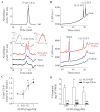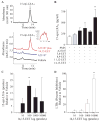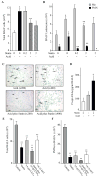Lovastatin decreases acute mucosal inflammation via 15-epi-lipoxin A4
- PMID: 20130564
- PMCID: PMC3260795
- DOI: 10.1038/mi.2009.141
Lovastatin decreases acute mucosal inflammation via 15-epi-lipoxin A4
Abstract
The widespread use of statins for hypercholesterolemia has uncovered pleiotropic anti-inflammatory properties that were unexpected based on the drugs' original design; yet, mechanisms for these protective actions remain uncertain. In this study lovastatin triggered biosynthesis of the anti-inflammatory and pro-resolving mediator 15-epi-lipoxin A(4) (15-epi-LXA(4)). During interactions between human neutrophils and airway epithelial cells, the statin-induced increase in 15-epi-LXA(4) was associated with increased 14,15-epoxyeicosatrienoic acid (14,15-EET) generation. When added to activated neutrophils, 14,15-EET enhanced 15-epi-LXA(4) biosynthesis. In a murine model of airway mucosal injury and inflammation, lovastatin increased 15-epi-LXA(4) formation in vivo and markedly decreased acute lung inflammation. Administration of 15-epi-LXA(4) also inhibited lung inflammation in an additive manner with lovastatin. Together, these results indicate that statin-triggered 15-epi-LXA(4) generation during human leukocyte-airway epithelial cell interactions is an endogenous mechanism for statin-mediated tissue protection at mucosal surfaces that may also be relevant in the statins' ability to stimulate the resolution of inflammation.
Conflict of interest statement
DISCLOSURES: CNS and BDL are co-inventors on patents on lipoxins that are assigned to Brigham and Women’s Hospital and have been licensed for clinical development and are the source of consultancies for BDL. The remaining authors have no conflict of interest to declare.
Figures




Similar articles
-
Lipoxin A(4) and aspirin-triggered 15-epi-lipoxin A(4) antagonize TNF-alpha-stimulated neutrophil-enterocyte interactions in vitro and attenuate TNF-alpha-induced chemokine release and colonocyte apoptosis in human intestinal mucosa ex vivo.J Immunol. 2001 Sep 1;167(5):2772-80. doi: 10.4049/jimmunol.167.5.2772. J Immunol. 2001. PMID: 11509622
-
15-epi-lipoxin A4 inhibits myeloperoxidase signaling and enhances resolution of acute lung injury.Am J Respir Crit Care Med. 2009 Aug 15;180(4):311-9. doi: 10.1164/rccm.200810-1601OC. Epub 2009 May 29. Am J Respir Crit Care Med. 2009. PMID: 19483113 Free PMC article.
-
Lipoxin A4 and aspirin-triggered 15-epi-lipoxin A4 inhibit human neutrophil migration: comparisons between synthetic 15 epimers in chemotaxis and transmigration with microvessel endothelial cells and epithelial cells.J Immunol. 2003 Mar 1;170(5):2688-94. doi: 10.4049/jimmunol.170.5.2688. J Immunol. 2003. PMID: 12594298
-
Lipid-derived mediators in endogenous anti-inflammation and resolution: lipoxins and aspirin-triggered 15-epi-lipoxins.ScientificWorldJournal. 2002 Jan 22;2:169-204. doi: 10.1100/tsw.2002.81. ScientificWorldJournal. 2002. PMID: 12806051 Free PMC article. Review.
-
Exploring new approaches to the treatment of asthma: potential roles for lipoxins and aspirin-triggered lipid mediators.Drugs Today (Barc). 2003 May;39(5):373-84. doi: 10.1358/dot.2003.39.5.740217. Drugs Today (Barc). 2003. PMID: 12861350 Review.
Cited by
-
Potential role of lipoxin in the management of COVID-19: a narrative review.Inflammopharmacology. 2022 Dec;30(6):1993-2001. doi: 10.1007/s10787-022-01070-3. Epub 2022 Sep 16. Inflammopharmacology. 2022. PMID: 36114383 Free PMC article. Review.
-
Intratracheal instillation of pravastatin for the treatment of murine allergic asthma: a lung-targeted approach to deliver statins.Physiol Rep. 2015 May 11;3(5):e12352. doi: 10.14814/phy2.12352. Physiol Rep. 2015. PMID: 25969462 Free PMC article.
-
Aspirin alone and combined with a statin suppresses eicosanoid formation in human colon tissue.J Lipid Res. 2018 May;59(5):864-871. doi: 10.1194/jlr.M078725. Epub 2018 Feb 14. J Lipid Res. 2018. PMID: 29444936 Free PMC article.
-
Repurposing High-Throughput Screening Reveals Unconventional Drugs with Antimicrobial and Antibiofilm Potential Against Methicillin-Resistant Staphylococcus aureus from a Cystic Fibrosis Patient.Antibiotics (Basel). 2025 Apr 14;14(4):402. doi: 10.3390/antibiotics14040402. Antibiotics (Basel). 2025. PMID: 40298549 Free PMC article.
-
Simvastatin attenuates rhinovirus-induced interferon and CXCL10 secretion from monocytic cells in vitro.J Leukoc Biol. 2014 Jun;95(6):951-9. doi: 10.1189/jlb.0713413. Epub 2014 Feb 14. J Leukoc Biol. 2014. PMID: 24532643 Free PMC article.
References
-
- Jain MK, Ridker PM. Anti-inflammatory effects of statins: clinical evidence and basic mechanisms. Nature Reviews Drug Discovery. 2005;4(12):977–87. - PubMed
-
- Kwak B, Mulhaupt F, Myit S, Mach F. Statins as a newly recognized type of immunomodulator. Nature Medicine. 2000;6(12):1399–402. - PubMed
-
- Mira E, et al. Statins induce regulatory T cell recruitment via a CCL1 dependent pathway. J Immunol. 2008;181(5):11. - PubMed
-
- Murphy DM, et al. Simvastatin attenuates release of neutrophilic and remodeling factors from primary bronchial epithelial cells derived from stable lung transplant recipients. Am J Physiol Lung Cell Mol Physiol. 2008 Mar;294(3):L592–9. - PubMed
-
- Takahashi S, et al. Reversal of elastase-induced pulmonary emphysema and promotion of alveolar epithelial cell proliferation by simvastatin in mice. Am J Physiol Lung Cell Mol Physiol. 2008 May;294(5):L882–90. - PubMed
Publication types
MeSH terms
Substances
Grants and funding
LinkOut - more resources
Full Text Sources
Other Literature Sources
Medical

